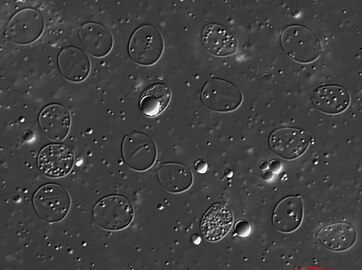Craterellus cornucopioides
| Craterellus cornucopioides | |
|---|---|

| |
| Scientific classification | |
| Domain: | Eukaryota |
| Kingdom: | Fungi |
| Division: | Basidiomycota |
| Class: | Agaricomycetes |
| Order: | Cantharellales |
| Family: | Cantharellaceae |
| Genus: | Craterellus |
| Species: | C. cornucopioides
|
| Binomial name | |
| Craterellus cornucopioides | |
| Craterellus cornucopioides | |
|---|---|
| Ridges on hymenium | |
| Cap is infundibuliform | |
| Hymenium is decurrent | |
| Stipe is bare | |
| Spore print is cream to buff | |
| Ecology is mycorrhizal | |
| Edibility is choice | |
Craterellus cornucopioides, or horn of plenty, is an edible mushroom found in North America and Eurasia. It is also known as the black chanterelle, black trumpet, trompette de la mort (French), trompeta de la mort (Catalan) or trumpet of the dead.
Etymology
The Cornucopia, in Greek mythology, referred to the magnificent horn of the nymph Amalthea's goat (or of herself in goat form), that filled itself with whatever meat or drink its owner requested. It has become the symbol of plenty.
A possible origin for the name "trumpet of the dead" is that the growing mushrooms were seen as being played as trumpets by dead people under the ground.[original research?]
It is one of several species that may be called djondjon in Haitian.
Description
The fruiting body is shaped like a funnel expanded at the top, the stalk seamless with the cap, which is .5–7 centimetres (1⁄4–2+3⁄4 inches) in diameter. They grow up to about 10 cm (4 in) tall,[1][2][3] exceptionally 15 cm (6 in).[4][5] The upper and inner surface is black or dark grey, and rarely yellow.[3] The lower and outer fertile surface is a much lighter shade of grey. The fertile surface is more or less smooth but may be somewhat wrinkled.
The size of the elliptical spores is in the range 10–17
Similar species
Craterellus cornucopioides has a smooth spore-bearing surface, but the rare, distantly related
The forms
Distribution and habitat
This fungus is found in woods in North America, Europe, and East Asia.[8] In the American Pacific Northwest, it grows from November to March.[9] It mainly grows under beech, oak or other broad-leaved trees, especially in moss in moist spots on heavy calcareous soil.[4][5] In Europe it is generally common but seems to be rare in some countries such as the Netherlands. It appears from June to November,[2] and in the United Kingdom, from August to November.
Because the mushroom tends to be blackish, it easily blends in with
Uses
Despite their unpalatable appearance, horns of plenty are edible and choice.
When dried, C. cornucopioides acquires
References
- ^ Roger Phillips: Mushrooms and other fungi of Great Britain & Europe (1981), Pan Books Ltd., London.
- ^ ISBN 2-603-00953-2, also available in English.
- ^ OCLC 797915861.
- ^ ISBN 0-340-39935-X.
- ^ ISBN 0-00-220012-0.
- ^ Kuo, M. (2003, June). The Cantharellus/Craterellus clade. Retrieved from the MushroomExpert.Com Web site: [1]
- S2CID 22745958. Retrieved 5 October 2014.
- ^ See the entry in the Global Biodiversity Information Facility.
- ^ "Seasonal Chart for Edible Mushrooms". Central Oregon Mushroom Club. Retrieved 2024-03-31.
- ^ Kuo, M. (2006, February). Craterellus cornucopioides. See the MushroomExpert.Com article.
- PMID 18538460.
- PMID 23419403.
- ISBN 978-1-4930-2669-2.

